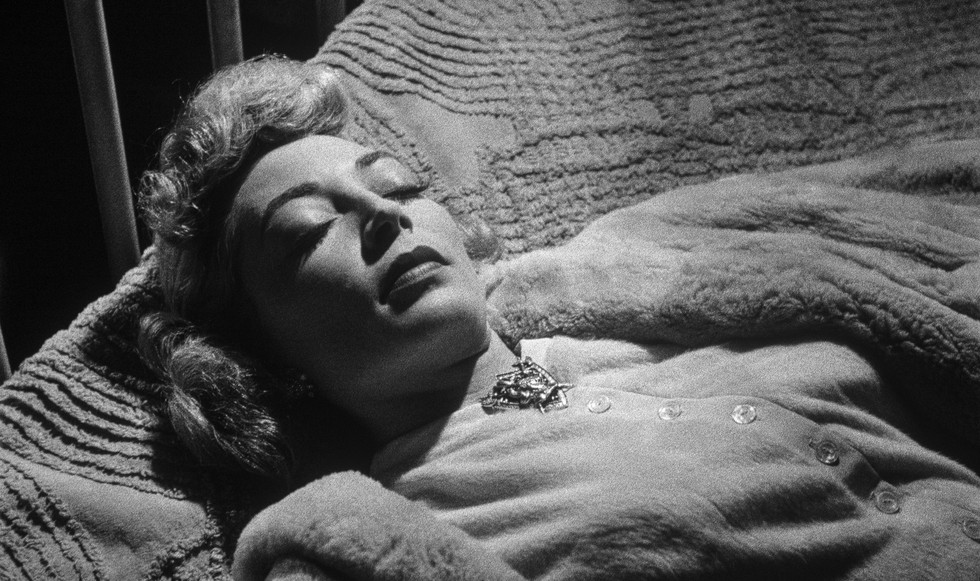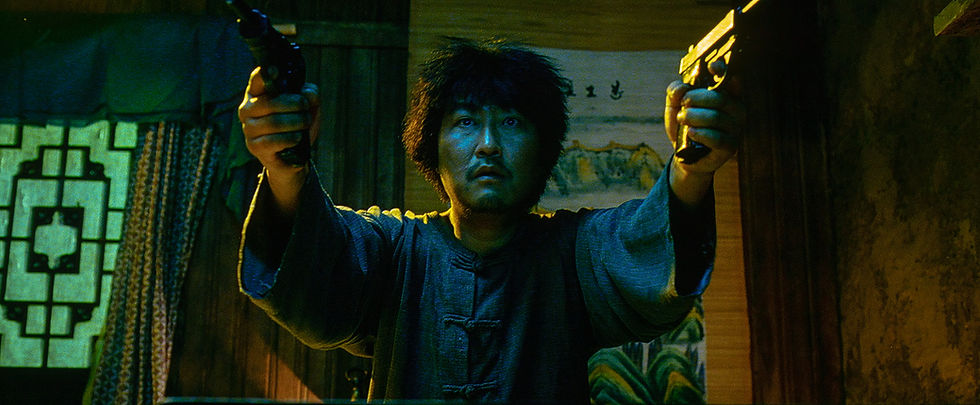Kubrick’s thriller – “The Killing” – is a hit on Kino Lorber’s 4K
- Bill Kelley III

- Aug 3, 2022
- 6 min read
Updated: Aug 4, 2022
4K ULTRA HD REVIEW / HDR FRAME SHOTS
Sterling Hayden plays ex-convict Johnny Clay, who just served a five-year sentence for robbery. Now he’s back leading a heist to grab $2 million in cash from a racetrack office.
(Click an image to scroll the larger versions)
“THE KILLING”
4K Ultra HD; 1956; Not Rated
Best extra: Commentary with author/film historian Alan K. Rode
HEIST FILMS got their start in the early 1950s with John Huston’s “The Asphalt Jungle” (1950), which was nominated for four Oscars. It was followed by British crime caper “The Lavender Hill Mob” (1951) with Sir Alec Guinness (“The Bridge on the River Kwai,” “Star Wars”) as a mild-mannered bank clerk with a plan to melt gold bars into souvenir Eiffel Towers. Huston’s electrifying 11-minute jewelry store heist for “Jungle,” became the blueprint for the French thriller “Rififi” (1955), with its dialogue-free, 28-minute safe-cracking sequence from blacklisted American director Jules Dassin (“Night and the City,” “The Naked City”).
Then, Guinness returned to play Professor Marcus, leading five oddball criminals in the British black comedy “The Ladykillers” (1955) written by American screenwriter William Rose. The gang rents an upper room from the delightful widow, Mrs. Louisa Alexandra Wilberforce (Katie Johnson), and they convince her that they’re classical musicians, who need a quiet room to rehearse. In reality, they’re plotting a robbery, which nearly goes off hitch-free, as she becomes an unwitting accomplice.
Back in the U.S., young filmmaker Stanley Kubrick formed a production company with producer James B. Harris (“Paths of Glory,” “Lolita”), after the limited and low-budget “Killer’s Kiss” (1955). Kubrick was paid $200K by United Artists for it and a future third film, which became “The Killing.” Kubrick co-wrote an adaptation of Lionel White’s 1955 pulp novel, “Clean Break” with Jim Thompson, the daring racetrack robbery led by protagonist Johnny Clay (Sterling Hayden), fresh out of prison.
(1) “The Killing” premiered on May 19, 1956, in New York City. (2&3) Racetrack bookkeeper Marvin Unger (Jay C. Flippen) gives bartender Mike O’Reilly (Joe Sawyer) a note detailing the time and place for the heist pre-meeting. (4&5) Johnny Clay and his longtime girlfriend Fay (Coleen Gray) talk about his next job and how it could be his last. (6) Marvin arrives at Fay’s apartment.
EXTRAS
During the lone bonus feature, author Alan K. Rode says Kubrick films are about “mastery that fails,” and the possible $2 million caper obviously fits the bill as it soon becomes “hell in a handbasket” during a high stakes horse race. The exteriors were mostly filmed at the Bay Meadows Racetrack in San Mateo, California, near San Francisco. And, the interiors at the old Charlie Chaplin studio off Sunset Boulevard, now part of The Jim Henson Company studio, and before that, the home of A&M Records for 30 years.
Harris was able to convince character actor Sterling Hayden to play Clay, insuring another 200K from United Artists for the production, and then raised another $120,000. Hayden nearly quit Hollywood six years earlier, but Huston convinced him to stick around and co-star in “The Asphalt Jungle.” Many now consider that performance his best as Kentucky-born hooligan Dix Handley, who dreams of buying his father’s horse farm back. But gambling is his nemesis, and he owes another gang member $2,300. His obsession also causes him to neglect his on-again, off-again girlfriend, Doll (Jean Hagen). Modern filmgoers will remember Hayden as the corrupt Irish-American policeman, Captain McCluskey in “The Godfather.”
Longtime movie and TV announcer Art Gilmore provides an uncredited narration throughout “The Killing,” which Kubrick and Harris were forced to include by the independent studio. At the time, many critics considered it the film’s weakest link and a distraction. But for Rode, who grew up hearing Gilmore’s voice on hundreds of movie trailers and the ‘50s TV series “Highway Patrol,” “Gilmore’s voice is always a welcomed present.”
(1&2) Gold-digger Sherry Peatty (Marie Windsor) hasn’t been happy in her five-year marriage to racetrack cashier George Peatty (Elisha Cook Jr.). So, when George goes to the heist meeting she meets up with her lover Val Cannon (Vince Edwards).
The cast for “The Killing” is a character actor’s “hall of fame,” which wasn’t by happenstance, Rode says. Kubrick was a “movie savant,” who knew every Hollywood and international film, plus viewed the Metropolitan Museum of Art’s entire film collection twice, making the producer/director an expert on every Hollywood actor. Harris once said in an interview, “He [Kubrick] drilled into my head that you live and die by your choice of actors. They can be brilliant and bring your film beyond your highest expectations.”
The cast included Marie Windsor as gold-digger Sherry Peatty, the wife of racetrack cashier George Peatty played by Elisha Cook Jr.; Vince Edwards as Val Cannon, Sherry’s lover; Coleen Gray as Johnny’s girlfriend Fay; Jay C. Flippen as Johnny’s old friend Marvin Ungr, and financier of the caper; Ted de Corsia as crooked cop Randy Kennan; Joe Sawyer as racetrack bartender Mike O’Reilly; Timothy Carey as sharpshooter Nikki; James Edwards as the African-American parking attendant; Joe Turkel as Tiny, and professional wrestler Kola Kwariani as wrestler Maurice Oboukhoff, who provides a diversion during the heist. Kubrick and Kwariani had become close friends, both avid chess players at New York’s Washington Square Park. And, just like a chess match, the plot jumps around: “If he does this, and I do that, and then he…” Kubrick even selected his then-wife Ruth Sobotka as the art director, who was an artist and dancer, and drew charcoal storyboards for every scene.
The late film critic Roger Ebert also selected “The Killing” as one of his all-time favorites for the second edition of his “The Great Movies” book. He said Kubrick considered the film his “first mature feature.”
(1-3) Mike O’Reilly, Cop Randy Kennan (Ted de Corsia) and George Peatty listen as Johnny reveals the details of the heist. (4&5) Sherry Peatty shows up at the front door snooping around and Johnny knocks her out. (6) Johnny sends George home and when Sherry wakes up he questions her, but she starts to flirt. (7) George questions Sherry if she really loves him.
VIDEO
MGM/UA with Kino Lorber provides another first-rate 4K/HDR presentation, in line with Kubrick’s second film “Killer’s Kiss” released last month on KL Studio Classics 4K disc. The original black and white camera negative (1.66:1 theatrical aspect ratio, filmed in an open matte), was scanned in 4K, providing cinematic texture throughout, with a good dose of natural film grain. Overall clarity is very good – especially with the numerous wide shots. “The Killing” was encoded onto a 66-gigabit disc, with an average video bitrate per second of around 75-Mbps. Only during the opening composite title sequence is the clarity softened.
The HDR10 and the more advanced Dolby Vision grading provide a well-balanced and advanced grayscale with darker black levels and more controlled highlights from previous editions. During the commentary, we learn cinematographer Lucien Ballard (“The Wild Bunch,” “True Grit”) was assigned by UA, but it was Kubrick who set up every single shot and made the lens selection. Remember, Kubrick got his start as a Look Magazine photographer during the late 1940s and early ‘50s.
Kubrick developed a number of wonderful tracking shots throughout as the camera moves from left to right and right to left following the movement of his actors. The shots accentuate the tension and the fast pace of the 84-minute film as the camera zips past a number of foreground objects. Director Steven Spielberg, a devoted student of Kubrick’s work, has used the tracking technique throughout his body of work. For example, during the opening of “Jaws” as the female swimmer runs along the sand dunes to go skinny dipping, the camera follows her in the background, as it races in front of a wooden fence.
AUDIO
The original mono 2.0 DTS HD soundtrack has been restored removing pops and hiss, and presented front and center with the dialogue-driven story, and Gerald Fried’s orchestral score.
Soon after “The Killing,” Kubrick and Harris would collaborate with co-producer/actor Kirk Douglas for the classic anti-war film “Paths of Glory” (1957), getting a Kino Lorber Studio Classics 4K release in late August.
― Bill Kelley III, High-def Watch producer
(1) Johnny meets with wrestler Maurice Oboukhoff (Kola Kwariani) at a local chess club, to go over his fight diversion during the heist. (2) Johnny will pay the sharpshooter Nikki (Timothy Carey) $5,000 for his part in the heist. (3) George is pressured by Sherry for the day and time of the heist. (4) At the racetrack parking lot, Nikki is confronted by the attendant (James Edwards). (5) The heist will take place during the seventh race. (6-8) Oboukhoff starts his diversion as Johnny watches and waits for the right moment.






















































Comments